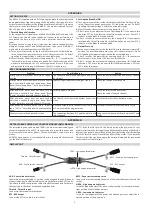
ASSEMBLY MANUAL XAIR F July, 21, 2009
MANUEL DE MONTAGE XAIR F 21 Juillet 2009 Page 68 / 84
©Randkar 2009
Prohibited reproduction
/ Reproduction interdite
TAKING DOWN AND TRANSPORT
Preparing the aircraft for transport on a trailer or for off airport storage is a simple operation
that needs two people and about 1/2 an hour.
It’s recommended to proceed as follows:
To avoid losing the parts removed, re-fit immediately the screws, nuts, pins and rings back
into their own parts immediately on removal.
-Take down the linking sail (upper and lower surface) between the wings.
-Disconnect the aileron and aileron return cables from their control levers.
(to avoid the cables from falling in the bottom of the wing, fit them on the keel with a
string or elastic strap).
-Remove the tension belts between the wings and store in a bag.
-Each wing strut has its own place, so mark them for easy assembly.
-Disconnect the rear jury strut from the trailing edge and fold it back along the wing strut.
-Disconnect the middle jury strut from the front wing strut and fold it back along the rear
wing strut.
-Disconnect the front jury strut from the leading edge and fold it back along the wing strut.
-One person hold up the wing at its tip. It will help if they lightly move or twist the wing, fol-
lowing the suggestions of his partner to make the pins removal easier.
Disconnect the rear wing strut from the trailing edge and put it on the ground.
Disconnect the front wing strut from the leading edge and put it on the ground.
Disconnect the leading edge from the keel plates.
Disconnect the trailing edge from the keel plates.
Remove the wing.
Disconnect the wing struts from the cockpit base.
-Proceed the same way for the second wing.
In the case of transport on a trailer, it is very important to protect with foam all the parts of
the aircraft that are in contact with other parts of the aircraft or in contact with the trailer, most
damage to aircraft is done on due to travelling vibrations and accidents.
Fit the cables to avoid loss.
In some countries, it’s needed to fold the stabiliser along the rudder, to reduce the width, ac-
cording to the road regulations:
-Disconnect the tips of the elevator fork from their control levers on the elevator assembly.
-Disconnect one of the rudder cables from the rudder.
-Take down the stabiliser struts.
-Fold the two half-stabiliser along the rudder.
-Fit together the stabilisers, elevators, fin and rudder.
Don’t forget to check the load a last time before leaving.
To re-built up, proceed in the reverse order, use new nuts,
control the path of the cables in their pulleys and don’t forget
too to make the check list before flying.
An example of a well-suited trailer...
DÉMONTAGE ET TRANSPORT
La préparation de la machine en vue d’un transport sur remorque ou d’un stockage dans un local
réduit est une opération simple nécessitant deux personnes et une petite heure.
Il est recommandé de procéder de la manière suivante:
Dans le but d‘éviter des recherches fastidieuses dans les fonds de poches lors du remontage, il est
conseillé de reposer tout de suite les vis, écrous, axes et goupilles fendues sur leurs pièces respecti-
ves.
-Déposer les toiles de liaison d’intrados et extrados à l’emplanture des ailes.
-Déconnecter les câbles de commande et de retour d’aileron de leur guignols.
Afin de pouvoir les récupérer facilement lors du remontage, fixer ces câbles sur la quille
à l’aide de cordelettes ou de ruban adhésif.
-Déposer les sangles de tension des ailes.
-Repérer les haubans en fonction de leur position.
-Déconnecter la contrefiche de hauban arrière du bord de fuite et la replier le long du hauban.
-Déconnecter la contrefiche de hauban avant du bord d’attaque et la replier le long du hauban.
- Déconnecter la contrefiche inter-hauban du hauban avant et la replier le long du hau
ban
arrière.
-Dans le cas d’un ventimètre avec prise d’air sur le hauban, déconnecter le tube de l’ins
tru-
ment, le sortir de la cellule et le fixer sur le hauban.
-Une personne soutient l’aile à son extrémité, elle pourra légèrement déplacer ou vriller
l‘aile
suivant les conseils de son acolyte pour faciliter l‘extraction des axes de fixa tion de haubans, bord
d‘attaque et bord de fuite.
Déconnecter le hauban arrière du bord de fuite, le poser à terre.
Déconnecter le hauban avant du bord d‘attaque, le poser à terre.
Retirer l’axe de fixation de bord d’attaque.
Retirer l’axe de fixation du bord de fuite.
Déposer l’aile.
-Déconnecter les haubans de leur fixation basse.
-Procéder de la même manière pour l’autre aile.
Dans le cas d’un transport sur remorque, il faut attacher une importance toute particulière à la pro-
tection des parties de toiles ou de tubes entrant en contact avec d’autres parties de la machine ou de
la remorque. Tous ces endroits soumis aux frottement générés par les vibrations du transport devront
être soigneusement protégés par des pièces de mousse. Penser également à fixer le mou des câbles.
il est également nécessaire d’intervenir sur l’empennage arrière afin de rester dans les limites de
gabarit routier.
-Déconnecter les embouts de fourche de commande de profondeur de leurs guignols respectifs sur
les plans de profondeur.
-Déconnecter une des extrémités du câble de direction sur la gouverne.
-Déposer les haubans d’empennage horizontal.
-Replier les empennages horizontaux le long de l’empennage vertical.
-Brider ensemble les plans horizontaux, de profondeur, le plan fixe vertical et la gouverne de direc-
tion.
Avant le départ, n’oubliez pas la visite pré-roule
Procéder dans l’ordre inverse pour le remontage. Penser à remplacer les écrous nylstop et à vérifier
le bon passage des câbles dans leurs poulies respectives.
.Ci-contre, un exemple de remorque bien adaptée...








































